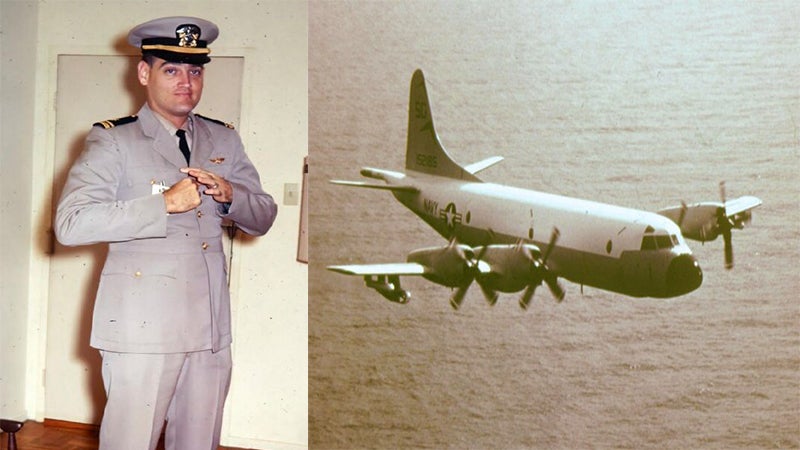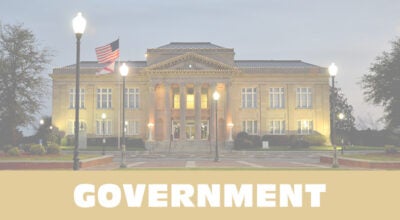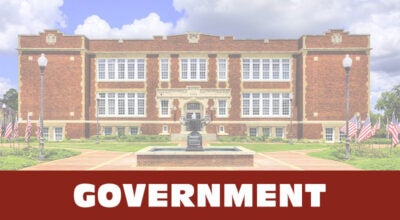Richard H. Merrill, Lieutenant, U.S. Navy, Naval Aviator, Vietnam
Published 1:00 pm Friday, August 11, 2023

- LEFT: Ltjg. Richard Merrill about the time of his Vietnam deployment. [Photo: Dr. Richard Merrill] RIGHT: A P3C Orion Navy patrol aircraft from VP-49 over the Gulf of Tonkin. [Photo: hemn.navy.mil]
|
Getting your Trinity Audio player ready...
|
Ltjg. Richard Merrill found himself in a tough spot, even for a naval aviator who was trained to get out of tough spots. His P3C Orion aircraft was being bounced around the sky like a feather in a strong summer storm. Bright flashes of lightning constantly lit up the cockpit as the torrents of rain pelted the windscreen with a vengeance. During the two hours of flying through the typhoon, Richard alternated between the co-pilot’s seat and the navigator’s station, aft of the flight deck. His walk between the cockpit and the navigator’s station was more of a controlled lurch as he tried to stay upright.
There was still afternoon sunlight, about an hour before, when they lifted off the runway at U-Tapao Airbase in Thailand. Their flight briefing included a warning about the typhoon, but the flight plan required them to fly through the typhoon, not around it. As soon as the typhoon was behind them, they resumed their patrol, flying at 1,000 ft. altitude at a speed of 200 knots. Their mission was to patrol the waters east of South Vietnam, searching for gun-runners trying to smuggle weapons to the Viet Cong.
Richard Henry Merrill was born on August 14, 1940, in Andalusia, Alabama. His parents were Ruth Hudson and Henry Clement Merrill. The Merrill’s would have two other children, a son, Phillip, and a daughter, Melissa. Richard attended East Three Notch Elementary School before entering Andalusia High School where he graduated in 1959. He enrolled at Marion Military Institute for a year before enrolling at Mississippi State University where he earned a degree in Animal Science in 1963.
After graduating from Mississippi State, Richard enrolled at Auburn University where he received a degree in Aviation Management in 1965. While at Auburn, he received his private pilot’s license. Just before graduating, he met two Navy officers who were recruiting for Aviation Officer Candidate School. Richard became interested and proceeded to take and pass the required tests.

Model of the P3C Orion Navy patrol aircraft given to Lt. Richard Merrill when he qualified as Aircraft Commander. [Photo: John Vick]
Richard was sent to Saufley Field where he flew the T-34 trainer for four months, then he was sent to Whiting Field for nine months training in the T-28. He returned to Pensacola for two months carrier qualification. That training included practice landing on the painted outline of a aircraft carrier flight deck on a runway. That was followed by five successful traps [a landing where the aircraft’s tail hook successfully catches an arresting wire] aboard the USS Lexington out in the Gulf of Mexico.
After carrier qualifications at Pensacola, Richard was sent to NAS Corpus Christi, Texas, for multi-engine training in a Grumman S2F. He received his Naval Aviator Wings about one year later and was assigned to VP-49 [Patrol Squadron 49], located at Patuxent River NAS, Maryland.
VP-49 flew the Lockheed P3C Orion patrol plane. Their primary duty was to patrol off the Atlantic coast, searching for Russian submarines. The aircraft had built-in MAD [magnetic anomaly detection] equipment. When the P3C overflew a submerged submarine, the MAD gear detected an anomaly and marked the location. The aircraft would then return and drop sonobuoys, which located the submarine by sonar [underwater sound detection]. Once a Russian submarine was located, the information was radioed back to a shore station.
The P3C carried a crew of three or four officers and eight enlisted sailors. Richard trained as third pilot, then co-pilot and finally pilot. The third pilot was responsible for navigation and the co-pilot was responsible for communications. He also became qualified as Plane Commander.
Richard remained at Patuxent River for three and a half years before he and the squadron were sent to the Vietnam theater. His son, Richard Mark, was born in 1968, two weeks before his dad’s deployment. They would also have two daughters, Leigh Ann born in 1971 and Tracie born in 1974.

Map of Thailand showing U Tapao Airbase where Lt. Merrill flew missions during Operation Market Time. [Photo: Pinterest]
U-Tapao was located near the coast of the Gulf of Thailand, south and to the east of Bangkok. Missions flown by VP-49 lasted about 10 hours and were timed so that as one plane was returning to base, another plane was already on station. The operation was called “Market Time,” and its purpose was to interdict shipments of weapons and supplies to the Viet Cong. The flights took off from U-Tapao, flew north to Udorn Airbase, turned east and overflew Laos, before crossing South Vietnam just below the DMZ [Demilitarized Zone. They then turned south into the Gulf of Tonkin and began their patrol along the Vietnamese coast.
Richard described a typical mission, “We flew in all weather conditions, including one flight when we flew through a typhoon. After leaving U-Tapao, we climbed to 20,000 feet and cruised at around 300 knots. When we reached the DMZ and turned south into the Gulf of Tonkin, we dropped down to around 1,000 feet at 200 knots so that we could spot gun-runners. If we located one, we dropped even lower [200 feet in daylight and 300 feet at night] and so that we could read the name on the boat. Once we identified the vessel, we called in the report to a command post in South Vietnam. If the vessel was suspicious, the Navy sent out a patrol boat to investigate.”
On another patrol, Richard’s plane came across a lone South Vietnamese river patrol boat about 20 miles off the coast. Richard recalled, “We came across boats of all kinds and didn’t pay much attention to this one even though it was odd to see a river patrol boat that far off the coast. Suddenly, they sent up a flare, which can be a distress signal. We called in the coordinates of the boat and later learned that the boat had lost power and had drifted 15-20 miles from the river.”
Richard deployed to U-Tapao three or four times during his tour at Sangley Point. After seven months, the squadron was returned to their base in the States at Patuxent River NAS.
In August 1970, Richard received orders to report to NAS Pensacola as a flight instructor with VT-3 [Training Squadron 3]. The squadron was located at Whiting Field near Milton, Florida. As an instructor in Transition, Precision and Aerobatics [TPA], Richard transitioned pilots from the T-34 training aircraft to the T-28, a larger and more powerful aircraft. When student pilots were qualified in the T-28, they were taught aerobatics by Richard and other instructors. Richard was discharged from the Navy in August 1971 after completing six years active duty. He had been awarded the Vietnam Campaign Medal, the Vietnam Service Medal, the National Defense Medal, the Air Medal with two Oak Leaf Clusters and the Meritorious Unit Commendation.
Richard Merrill entered the School of Optometry at the University of Alabama at Birmingham [UAB] in September 1971. He earned his Doctor of Optometry in 1975 and set up a practice on O’Neal Court in Andalusia, Alabama. Ten years later, Dr. Merrill purchased the practice of Dr. Dan McInnish, and moved his practice to Professional Court on East Three Notch Street.
In 2018, Dr. Merrill sold his records to Dr. James Barton and joined him in his practice located at Westgate Plaza in Andalusia. Dr. Merrill has been the referral Optometrist for the Andalusia Lions Club eyesight applications for many years. He and his wife, the former Marilyn Watts currently reside in Andalusia.
John Vick
The author thanks Dr. Richard Merrill for helping tell his story. They were teammates on the Andalusia High School football team in the 1950s. The author is a longtime member of the Andalusia Lions Club and thanks Dr. Merrill for his service to the club.





